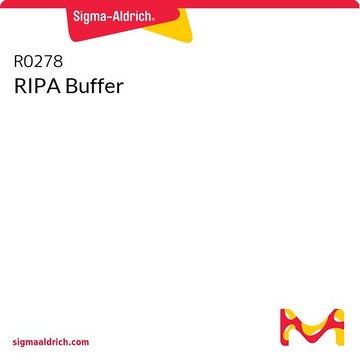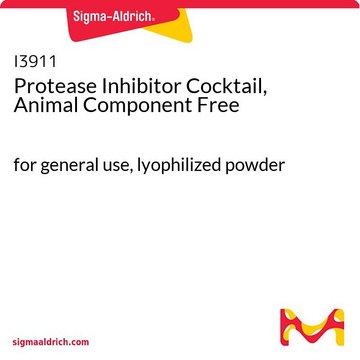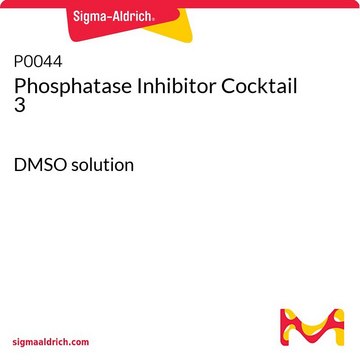I3786
Protease Inhibitor Cocktail
Animal-Free, DMSO solution, for the inhibition of serine, cysteine, aspartic proteases and aminopeptidases, for use with mammalian cell and tissue extract, DMSO solution
동의어(들):
Protease inhibitor
로그인조직 및 계약 가격 보기
모든 사진(1)
About This Item
UNSPSC 코드:
12352200
NACRES:
NA.77
solubility:
water: soluble
추천 제품
일반 설명
Components of this cocktail are of non-animal origin and no animal products were used in the component production process. All vessels and instruments used for the cocktail production are dedicated for animal component free production and have never encountered an animal product. Aprotinin used in this cocktail is a recombinant bovine protein expressed in plants (Nicotiana).
This protease inhibitor cocktail has been optimized and tested for mammalian cell and tissue extracts.
특이성
Inhibits serine, cysteine, aspartic proteases, and aminopeptidases.
애플리케이션
Animal component free (ACF). Optimized and tested for general use. Can also be used for purification of histidine-tagged proteins, as chelating agents have been omitted.
성분
AEBSF
Aprotinin
Bestatin
E-64
Leupeptin
Pepstatin A
Aprotinin
Bestatin
E-64
Leupeptin
Pepstatin A
물리적 형태
The components in this ACF protease inhibitor cocktail do not originate from animal sources and can thus be used in the production of animal-free proteins.
This ACF cocktail is supplied as a ready-to-use solution in DMSO. One ml of the cocktail solution is recommended for the inhibition of endogenous enzymes found in 100 mL of lysate from 20 g (wet weight) of bovine liver, or 10 mL of cell lysate obtained from CHO cells at a cell density of 108 cells per mL.
신호어
Warning
유해 및 위험 성명서
Hazard Classifications
Eye Irrit. 2 - Skin Irrit. 2
Storage Class Code
10 - Combustible liquids
WGK
WGK 2
Flash Point (°F)
188.6 °F - closed cup
Flash Point (°C)
87 °C - closed cup
이미 열람한 고객
Gold nanoparticles do not induce myotube cytotoxicity but increase the susceptibility to cell death.
Paulo Emílio Corrêa Leite et al.
Toxicology in vitro : an international journal published in association with BIBRA, 29(5), 819-827 (2015-03-21)
Gold nanoparticles (AuNP) have been widely used for many applications, including as biological carriers. A better understanding concerning AuNP safety on muscle cells is crucial, since it could be a potential tool in the nanomedicine field. Here, we describe the
Yue Gao et al.
Biomedicine & pharmacotherapy = Biomedecine & pharmacotherapie, 129, 110396-110396 (2020-06-25)
Systemic lupus erythematosus (SLE) is an autoimmune disease that is mainly caused by excessive accumulation of autoantibodies that target autoantibodies such as nucleic acids. T helper (Th) cell have been associated with the development of SLE. Typically, different subsets of
Wimonrat Panpetch et al.
Frontiers in immunology, 11, 561652-561652 (2020-10-27)
Obesity induces gut leakage and elevates serum lipopolysaccharide (LPS), a major cell wall component of Gram-negative bacteria, through gut translocation. Because Candida albicans is prominent in human gut but not in mouse, C. albicans, a source of (1→3)-β-D-glucan (BG) in
Mo Shen et al.
Molecular medicine reports, 16(1), 937-942 (2017-06-07)
The role of inflammation in tumorigenesis and development is currently well established. Lymphotoxin β receptor (LTβR) activation induces canonical and noncanonical nuclear factor (NF)‑κB signaling pathways, which are linked to inflammation‑induced carcinogenesis. In the present study, 5,637 bladder cancer cells were
Jasim Khan et al.
Toxicology, 428, 152299-152299 (2019-10-02)
Bisphenol A (BPA) is a ubiquitously distributed endocrine disrupting chemical (EDC). BPA exposure in humans has been a matter of concern due to its increased application in the products of day to day use. BPA has been reported to cause
자사의 과학자팀은 생명 과학, 재료 과학, 화학 합성, 크로마토그래피, 분석 및 기타 많은 영역을 포함한 모든 과학 분야에 경험이 있습니다..
고객지원팀으로 연락바랍니다.













